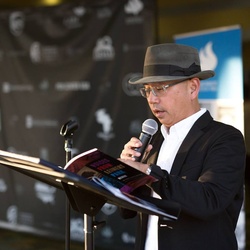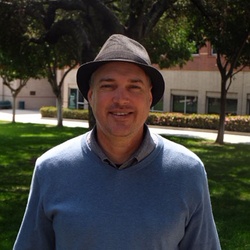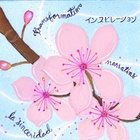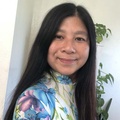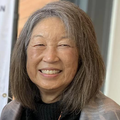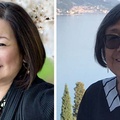We have a focus on Little Tokyo as inspiration and a special triple threat treat for this month’s edition of Nikkei Uncovered. First, we have a piece from D Hideo Maruyama, based in LA and a veteran of the Asian American literary scene. Next is poetry from third generation LA native, Mike Sonksen, accompanied by artwork by his wife and Tokyo-born/LA-raised Emi Motokawa Sonksen. The literary and creative work from all three of these artists continues to make a substantial impact on the Asian American community and Los Angeles as a whole. We’re excited to include just a small sample here of their work in relation to our beloved Little Tokyo - enjoy!
— traci kato-kiriyama
* * * * *
D Hideo Maruyama obtained his MFA in Creative Writing from Long Beach State. He was a part of Aisarema, the nonprofit wing of the shuttered Amerasia Bookstore during 90s to early 2000s. It produced the Asian Pacific American Arts journal called dIS*orient Journalzine, and he was an editor. He was included in the anthology Voices of Leimert Park Redux, and he is currently working on a body of poetry, prose and essays to be compiled into a multi-genre text in the literary vein of Jean Toomer’s Cane or Theresa Hak Kyung Cha’s Dictee.
Godzilla of the Mitsuru Toy Shop
My mother used to drag me to work
At the Mitsuru Toy shop on weekends.
I used to like to look at the Bandai die cast toys:
Kamen rider, Raideen, and Ultraman figures.
But there was a one foot tall Godzilla figure,
Not the new version, but the 1950s version,
When you pressed a button, it would replay
The Japanese newscaster broadcasting his doom.
During Nisei Week, we would get interesting customers.
One day a man and his wife walked in.
My mother said she loved him in the TV show Taxi.
Danny DeVito promptly introduced his wife, Rhea Perlman.
Mitsuru Restaurant a few doors down would sell imagawayaki.
The Amezaiku man often sculpted his candies as people would snack.
He would shape molten hard candy into dragons, rabbits and horses.
They were so intricate that I would not eat one for over a week.
One day, there were these four guys who came in browsing.
We asked them where they were from, and they said Georgia.
They said they were a band and touring the area.
They were intrigued by the various Manga figures in the store.
The man who said his name was Michael came across Godzilla and triggered it.
He called his other friends to listen to it, and they said it might be useful.
They ask the price of the figure, and they don’t blink at the cost.
I wrapped up Godzilla into a box and sent him on his way out.
A few years later, I’m listening to the radio.
I hear the sample from the 1950s Godzilla film,
Then I hear Michael Stipe of REM singing,
I am, I am, I am Superman and I know what's happening.
No, I think. It could not have been those guys.
Probably not I think, but I still wonder about it.
* This poem is copyrighted by D Hideo Maruyama (2018)
* * * * *
Mike Sonksen, is a 3rd-generation L.A. native whose prose and poetry have been included in programs with the Mayor’s Office, the Los Angeles Public Library’s “Made in LA” series, and Grand Park. Most recently, one of his KCET essays was nominated for an Award with the LA Press Club. Sonksen teaches at Woodbury University where he was awarded by the Associated Students Organization for Excellence in Teaching. His city tours have been sponsored by the Museum of Neon Art and the City of Los Angeles’s Department of Cultural Affairs.
His poetry is accompanied by an art piece created by his wife, Emi Motokawa Sonksen. Born in Tokyo, and raised in Los Angeles, she studied Buddhism in Japan after college. Following a career as a flight attendant, she awoke to her artistic calling. Emi has shown at the Japanese American National Museum, La Luz de Jesus Gallery, William Grant Still Community Art Center and Hsi Lai Buddhist Temple. In 2016, her image of the City of Monterey Park was chosen for a Metro poster. Through her art, she wants to tickle souls. Her paintings, illustrations and crocheted dolls are inspired by Buddhist concepts and combine multiculturalism, hip-hop and Japanese anime.
Homage to Little Tokyo
(Over the last 20 years I’ve spent many nights
& days in Little Tokyo, this poem is my tribute)
Little Tokyo is Los Angeles’s
second oldest community
the cultural spine runs between
First and Second Street, bonded
by community history, common ancestry
& the legacy of internment
The Japanese American National Museum
is a nexus
Little Tokyo is undergoing transformation.
The specter of gentrification, rising rents
& cookie cutter condos continues to alter
the original footprint
The size has transitioned
but development will never kill
the vision or the district’s defining spirit.
The boundaries transcend geography:
Little Tokyo is Obon dancing
in the middle of First Street.
Little Tokyo is a cultural grounding
George Abe playing flute under
the grapefruit tree browsing books
at the AmerAsian bookstore
Little Tokyo is traci kato-kiriyama taking the stage
at the Aratani Theater or Jason Arimoto
on Ukulele singing passionately:
Let My love surround you
Little Tokyo is FandangObon bridging Japanese,
Mexican & African American communities
Little Tokyo is over a thousand people
dancing down Halldale in Gardena
on a hot August evening
Little Tokyo is a cruise down Alameda
pedal with the Eastside Riders
down Central Avenue
through the corridor to the Watts Towers
Little Tokyo is Bronzeville,
Charlie Parker blowing on First Street
Little Tokyo is Scott Kurashige writing
about The Shifting Grounds of Race,
the Crenshaw District was once the largest
Japanese neighborhood in America
The birthplace of Yellow Brotherhood & Gidra
Little Tokyo is the Poetry of Amy Uyematsu
the prose of Naomi Hirahara, the photography
of Mike Murase, the haiku of Rubén Guevara,
Little Tokyo is the sacred song of the Sangha
chanting Namo Myo-ho Renge Kyo
Little Tokyo is the Japanese Village Plaza,
Toyo Miyatake’s camera,
a pitcher of cold Asahi beer,
Noguchi’s sculpture,
Little Tokyo is skaters rail sliding
in the courtyard
Little Tokyo is the Go For Broke Memorial,
Suehiro Cafe, Fugetsu-Do, Monzo’s Udon
Noodle’s, Katsu Don from Curry House,
an izakaya on the corner,
four food trucks on First,
Shop, share, support
Little Tokyo is legacy businesses,
Nisei witnesses
Little Tokyo is Boyle Heights across
the First Street bridge.
There were once wildflowers
on the edge of the Wolfskill Orchard
Little Tokyo is taiko drumming
a long list of lullabies redefining courage
Little Tokyo is Transpacific Borderlands, the art
of the Japanese Diaspora in Lima, Los Angeles,
Mexico City & São Paulo
Little Tokyo is Yayoi Kusama's
Infinity Mirrors
Little Tokyo is Emi Motokawa crocheting
Kokeshi dolls, Little Tokyo is Eka Loa
& Skye Ren eating shaved ice at Mikawaya
Little Tokyo is Scott Oshima at
Sustainable Little Tokyo preserving history
Little Tokyo is Kristin Fukushima at
The Little Tokyo Community Council
protecting the district from financial predators
looking to take a piece of the neighborhood
Little Tokyo is the Little Tokyo
Service Center serving the
Center of the district with
intergenerational coalitions
sustaining the civic legacy
through people power & policy
Even if the eastern section of Little Tokyo
attempts to call itself the Arts District
with luxury condos now leasing
The energy of the enclave
will never be destroyed,
the song remains the embodiment,
a sort of anchoring
Little Tokyo is Manzanar,
Little Tokyo is Nisei gardeners &
J-A Nurseries before the interstate
Little Tokyo is the Japanese American
Cultural Center, Little Tokyo
is youth basketball on Saturday
in the Budokan with a 38,000
square foot mezzanine
Little Tokyo is California Oak wine
barrels, the tree is over 150 years old
Little Tokyo is a Japanese folk song,
pounding rice, sifting grain, holding hands
with nothing to fear. If you’re gonna be
a fool, you might as well dance
Little Tokyo is Los Angeles
* This poem is copyrighted by Mike Sonksen (2018), artwork copyrighted by Emi Motokawa (2018).
© 2018 D Hideo Maruyama; Mike Sonksen; Emi Motokawa




